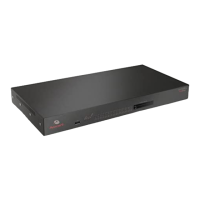Chapter 2: Installation 19
To change the IP configuration:
1. Enter
cd /Units/Appliance_Settings/Network/Devices/eth0/Settings at the CLI prompt.
--|- Units cli-> cd /Units/Appliance_Settings/Network/Devices/eth0/Settings
2. Set the desired parameters.
3. Enter
commit at the CLI prompt to save the new parameters.
--|- Units cli-> commit
Ways to Access the Web Manager
The console server comes from the factory with DHCP enabled. Users can access the Web
Manager with either a DHCP-assigned IP address, an administrator-assigned static IP address or
the default IP address (192.168.160.10). For information on how to log in, see Log Into the Web
Manager on page 25.
If you do not configure a static address, if a DHCP server is not on the network or if it fails to
discover the IP address of the console server, you can enter the default static IP/subnet mask
addresses of 192.168.160.10/255.255.255.0 for eth0 and 192.168.161.10/255.255.255.0 for eth1.
To use the default IP address to access the Web Manager:
Both the desktop and the appliance should be in the same physical network. Add the host route
192.168.160.10/32 to the Ethernet interface. The following example adds the route to eth0 on the
console server on a Linux machine:
#
route add - host 192.168.160.10 eth0
First Time Configuration
The first time that the admin logs into the Web Manager after installation, the First Time
Configuration screen appears. An administrator uses the options in the left menu to enable and
configure security, ports and users.
Table 2.4: First Time Configuration Menu Options
Option Description
Security Enable or disable automatic detection of PC cards and the download of PC card
drivers.
Enable or disable RPC.
Allow all users to access enabled ports or restrict access.
Select a security profile, which defines:
• which services (FTP, ICMP, IPSec, Telnet) are enabled
• Configuration for SSH and HTTP/HTTPS access.
The administrator can select either a preconfigured security profile or create a
custom profile.

